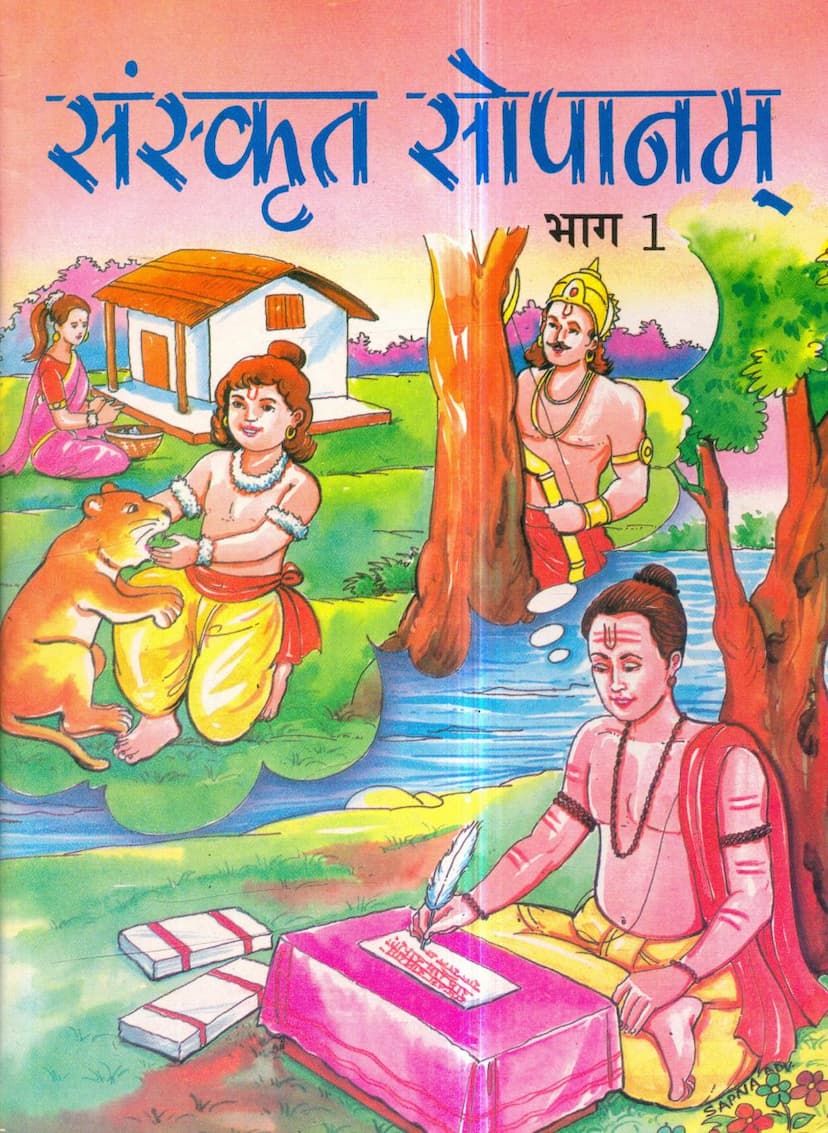Sanskrit Sopanam Part 01
Added to library: September 2, 2025

Summary
This document is a comprehensive Sanskrit textbook titled "Sanskrit Sopanam Part 01" authored by Dr. Surendra Gambhir and published by Pitambar Publishing Company. It is designed to teach Sanskrit in a systematic and engaging manner, catering to students of various age groups and needs.
The book emphasizes a pedagogical approach that blends language acquisition with an appreciation for Sanskrit literature and culture. It acknowledges the modern understanding of language learning as an art, focusing on efficient teaching methods. The core skills of language learning—listening, speaking, reading, and writing—are addressed, with a particular emphasis on reading and comprehension for Sanskrit. Speaking skills are also incorporated to build student confidence and interest.
Key features of the textbook include:
- Gradual Progression: The content is structured to be sequential, building a strong foundation in Sanskrit. Each word and sentence is carefully chosen and placed to facilitate learning.
- Interactive Learning: The book incorporates simple Sanskrit verses and everyday conversational sentences at the beginning to foster an interest in the language.
- Holistic Approach: Beyond grammar and vocabulary, the lessons also touch upon themes related to science, culture, and social knowledge.
- Practical Application: Exercises are provided for both oral and written practice, including pronunciation drills, sentence construction, translation, and vocabulary building.
- Grammatical Foundation: The book systematically introduces Sanskrit grammar, including the alphabet (varnamala), noun declensions (for masculine, feminine, and neuter genders), pronouns, verb conjugations across different tenses (Lat-lakar, LrL-lakar), and case endings (Vibhakti).
- Engaging Content: Stories, dialogues, and illustrative examples are used to make the learning process enjoyable.
- Comprehensive Dictionary: A glossary of Sanskrit words with their Hindi equivalents is included at the end of the book to encourage vocabulary study.
The table of contents (Page 5) outlines the following chapters:
- Varnamala (Alphabet)
- Akaraanta-Pullingam (Masculine Nouns ending in 'a')
- Pratham Purush - Ekavachanam (Third Person Singular)
- Pratham Purush - Dvivachanam (Third Person Dual)
- Pratham Purush - Bahuvachanam (Third Person Plural)
- Akaaraanta-Strilingam (Feminine Nouns ending in 'aa')
- Pratham Purush - Strilingam (Third Person Feminine Singular, Dual, Plural)
- Akaaraanta-Napumsaklingam (Neuter Nouns ending in 'a')
- Pratham Purush - Napumsaklingam (Third Person Neuter Singular, Dual, Plural)
- Madhyam Purush - Ekavachanam (Second Person Singular)
- Madhyam Purush - Dvivachanam (Second Person Dual)
- Madhyam Purush - Bahuvachanam (Second Person Plural)
- Uttam Purush - Ekavachanam (First Person Singular)
- Uttam Purush - Dvivachanam (First Person Dual)
- Uttam Purush - Bahuvachanam (First Person Plural)
- LrL-lakarah (Future Tense)
- Karma-Karakam (Accusative Case - Dwitiya Vibhakti)
- Karana-Karakam (Instrumental Case - Tritiya Vibhakti)
- Sampradana-Karakam (Dative Case - Chaturthi Vibhakti)
- Apadana-Karakam (Ablative Case - Panchami Vibhakti)
- Sambandha-Karakam (Genitive Case - Shashti Vibhakti)
- Adhikaraṇa-Karakam (Locative Case - Saptami Vibhakti)
- Sambodhanam (Vocative Case)
- Sankhya (Numbers)
- Gramah (The Village)
- Trayah Dhurtah Brahmanah Cha (The Three Cheats and the Brahmin)
The book also includes sections on common Sanskrit words, verb roots (Dhatavah) categorized into regular, semi-regular, and irregular, prefixes (Upsargayukta Dhatavah), numbers, and special rules for case usage, adjective agreement, and indeclinables (Avyayaha). A comprehensive Sanskrit-Hindi glossary is provided at the end.
The overall aim of "Sanskrit Sopanam Part 01" is to make the learning of Sanskrit accessible, effective, and enjoyable, fostering a love for the language and its rich heritage.